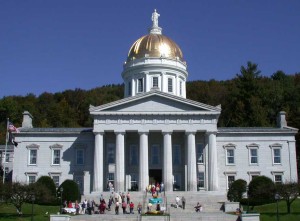
Vermont state capitol building. Photo: Wikipedia.
By George Harvey
Some Vermont communities have been struggling for a long time to get some control over siting of renewable energy systems that would be built within their bounds. This year, their struggles have become newly energized.
The underlying problem is that the Vermont Public Service Board (PSB) has nearly all control over siting approvals, leaving none to the communities where the projects will be built. The idea that local communities should have control over their own territories is perfectly understandable and has very wide appeal.
A problem is that there are two sides to this issue. The movement to ensure the rights of communities has a widespread and real appeal. People all over the state want to maintain the integrity of their communities and their own homes. They want to protect what they have.
The other side of this issue, however, is a need to address far greater threats to the communities over Vermont and the people who live in them. Our forests, our farms, our health, the security of our lives are being threatened by things that are altogether too real, too present, and too powerful. The negative effects of climate change have already arrived and are getting worse. They range from Lyme disease being spread by non-native ticks to increased storm damage, such as what we had with hurricanes Sandy and Irene.

A town meeting in Huntington, VT. Photo: Wikipedia.
While we know we can lose power for days in a bad storm, we should recognize that such an event is not even close to a worst-case scenario. The Federal Energy Regulatory Commission has warned us that we could lose electrical power over the whole nation for over a year, if a carefully executed plan for terrorists to attack eight largely unprotected sites were successful. NASA warned us that the national grid might have gone down for upwards of three years if a solar coronal ejection that barely missed us had hit.
We will not stop climate change alone, and we will not be able to stop coronal ejections from hitting the Earth, but we can do a lot to protect our way of life. Happily, there is a way to protect ourselves from a large variety of potentially disastrous problems. To do that, we have to implement plans for resilience. And interestingly, the state and federal plans will not work as well as local ones. We have to act on the level of the home, the neighborhood, and the community to do the work best.
The movement to give communities power in siting questions is clearly intended to make it possible to prevent renewable power capability from being installed. Nevertheless, it can also be used to give communities an ability to plan for a resilient future, in which they have no control over long-term system failures.
Fortunately, there may be a way to do this that could cost nearly nothing. We might suggest that communities be given power to prevent renewable energy facilities from being sited within them, but linked to that power should be responsibility to determine how the communities improve resilience and what renewable power systems should be installed. This could be done by having each town meeting annually, have an article on its agenda, required by the state, to vote on its resilience plan, which would be put on record with the state. Cities would be required to act similarly through their city councils or other governance.
This should not be an onerous task. Sending a description of the plan to the state might be as simple as drafting a letter saying, “We have no plan.” But it would mean that the issue is before the eyes of every voter, to be discussed annually.






Leave a Reply